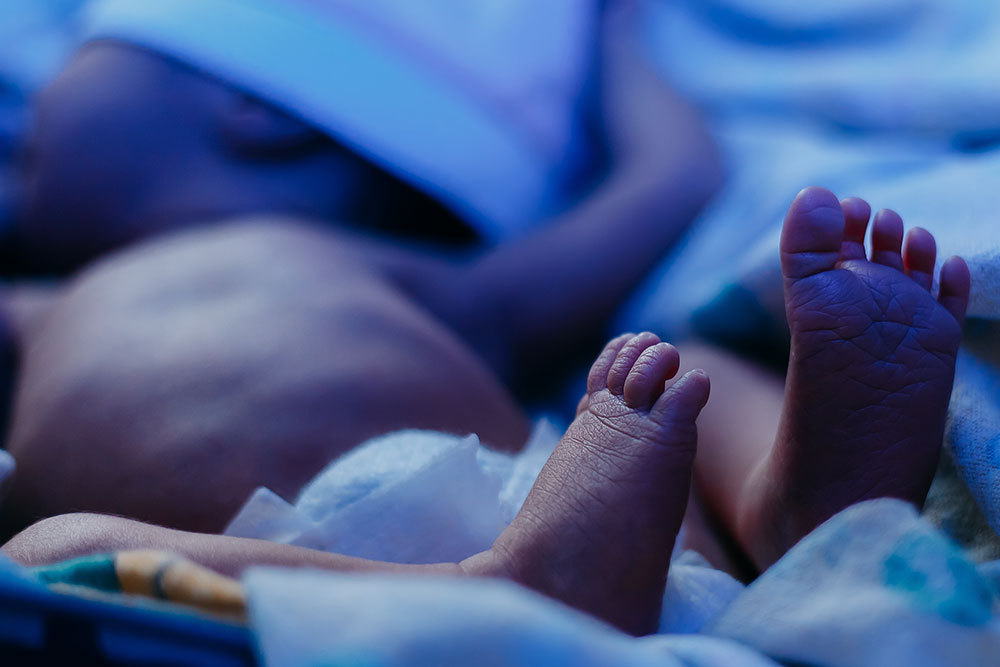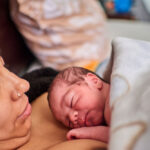What Happens When Your Newborn Has Jaundice

Most babies are screened for jaundice before leaving the hospital. Here's what you need to know if your child is affected.
Medical Experts: Maria Mendlovsky, CPNP; Danielle Rush, BSN, RNC-EFM
You’re over the hard part. You made it through 40 (or so) long weeks of pregnancy, then labor and delivery. Your sweet newborn is finally here! But now, after routine screenings, your neonatologist or nurses are concerned that your baby is jaundiced. What does this mean and what will happen next?
Neonatal jaundice, or hyperbilirubinemia, is the most common infant medical problem during the first two weeks of life. Approximately 60% of term infants (born after 37 weeks) and 80% of preterm infants (born before 37 weeks) will develop jaundice during this time. In fact, it’s so common that the American Academy of Pediatrics (AAP) recommends all newborns be evaluated for jaundice before being discharged from the hospital.
Most often the condition recovers on its own and no treatment is needed. However, sometimes jaundice can be the result of a more serious condition and treatment is necessary. Left untreated, severe jaundice can be harmful to a newborn’s central nervous system.
Because jaundice is so common, it’s beneficial to understand what it is and how different treatment options can affect your family in the earliest days of parenthood. With this knowledge, you’ll be better prepared for after your little one has arrived.
What Is Jaundice?
Neonatal jaundice is a condition caused by an increase of bilirubin circulating within the baby’s blood serum. Bilirubin is a yellow-colored byproduct of broken-down red blood cells. Typically, the baby’s liver helps to break down bilirubin so it can be eliminated through passing stools. But a buildup of bilirubin will turn baby’s skin and mucous membranes yellow when not removed from the body.
Before an infant is born, the placenta helps to process bilirubin from the developing baby’s body. After delivery, the newborn’s liver takes on the responsibility of processing bilirubin, though it may take some time to do this effectively.
Types of Jaundice
There are two types of jaundice, Unconjugated Hyperbilirubinemia (UHB) and Conjugated Hyperbilirubinemia (CHB). There are two reasons why either type of jaundice may develop. A physiological development means that jaundice is related to the body’s normal functioning. A pathological development means that the jaundice is related to an external problem, disease, or disorder. It is vital to distinguish the type and reason for an infant’s jaundice.
Unconjugated hyperbilirubinemia
UHB means that the bilirubin present in the blood is not fully broken down to be eliminated from the body. Approximately 75% of UHB jaundice has a physiological development. This means there is a delay in newborn bilirubin metabolism and its ability to handle the initial overload of short-lived red blood cells and decreased activity of a bilirubin breakdown enzyme. Physiological UHB can be considered a normal and expected development in a newborn and does not always require treatment.
Conversely, pathological UHB develops because of an external problem, disease, or disorder. It occurs within the first 24 hours of life, or when serum bilirubin levels rise by a significant interval each day, or each hour, or are still present at two to three weeks of life. This type of jaundice may require treatment. The most significant causes of pathological UHB include:
- Blood group incompatibility between pregnant parent and newborn such as Coomb’s +
- Breast milk jaundice
- Breastfeeding jaundice
- Hemolysis: red blood cell breakdown which can be the result of several disorders, such as G6PD, or birth injuries that may cause pooling of blood under the skin of the scalp. This may occur after a difficult vaginal delivery or a vacuum-assisted birth.
Conjugated hyperbilirubinemia
CHB is a rarer type of jaundice in which the blood serum levels of broken-down bilirubin are elevated and the development is frequently pathological. Causes of CHB include:
- Obstruction of bile flow: biliary atresia is the most common
- Infections
- Genetic causes
- Neonatal hepatitis
Breastfeeding and Jaundice
While we are avid “fed is best” advocates at Pregnancy & Newborn, we know that science has proven that breast milk is the ideal food for babies. However, it is important to know that breastfed infants are 3 to 6 times more likely to experience jaundice that may need treatment.
Breastfeeding jaundice occurs within the first week of life and is caused by a low or inadequate intake of breast milk. This decreased milk intake delays the passage of high bilirubin-containing meconium—or baby’s first poop. This bilirubin is reabsorbed by the body, and the infant may become dehydrated and lose more weight than expected. In this case, breastfeeding should continue with increased frequency but supplementation may need to be considered.
Breast milk jaundice occurs after one week of life and the cause is not well understood. Substances in breast milk may slow newborn bilirubin metabolism. The newborn’s serum bilirubin levels should decrease after two weeks of life.
Maria Mendlovsky, a certified pediatric nurse practitioner (CPNP) who works for Central Avenue Pediatrics in Scarsdale, New York, a division of Boston Children’s Health Physicians, shares her experience regarding some exclusively breastfed babies and jaundice.
Mendlovsky notes, “since the establishment of baby-friendly [birth facilities] and the promotion of exclusive breastfeeding, I have seen a significant increase of newborn jaundice, hypernatremia (high blood sodium levels), and dehydration in breastfed babies. Some parents leave the hospital with the expectation that every breastfed baby is getting adequate nutrition. But, they don’t realize that every mother is different, that every baby is different.”
What Happens if Your Newborn Has Jaundice?
Soon after birth, your neonatologist or pediatrician will need to evaluate your newborn to establish the cause of their jaundice. They will consider any complications you may have had during pregnancy and delivery. They will also evaluate your infant’s feeding habits and the frequency of wet and dirty diapers. The treatment for neonatal jaundice will depend on the cause but usually involves phototherapy, a type of treatment that uses ultraviolet light directly on the skin.
Signs and symptoms of jaundice
The nurses and physicians providing care to your newborn have a keen eye for identifying jaundice. Signs and symptoms include:
- Difficulty waking or if baby appears very fatigued
- Difficulty feeding, whether from breast or bottle
- Yellowing of the skin; skin discoloration begins from the head and moves toward the toes. (It is important to observe the baby in daylight and apply pressure to the skin to reveal the color of the underlying tissue, which is more difficult to detect in darker-skinned infants.)
- Yellowing of the whites of the eyes, which is more evident in infants with darker skin
- Inadequate wet and dirty diapers with or without uric acid crystals
- Weight loss
Testing
Most hospitals perform jaundice screenings on every infant. Initial testing may involve a transcutaneous bilimeter, a noninvasive device that can detect bilirubin levels through the skin. If this noninvasive approach is not available or if the transcutaneous bilimeter reports a high reading, a blood sample will be taken from the infant’s heel to accurately detect the serum bilirubin levels. In some cases, a reticulocyte-immature red blood cell count and testing for G6PD deficiency—a genetic disorder—may be included to rule out hemolytic disease that results in jaundice.
Once detected, physicians follow a treatment guide for jaundice, an algorithm that includes the number of hours old an infant is, the bilirubin blood sample time, and the number of weeks pregnant at delivery.
Treatments
Feeding
Feeding should occur on demand until the baby is satisfied, whether by breast, bottle, or other feeding methods. Supplementation of formula, expressed breast milk, or donor breast milk may be recommended, depending on the cause and progression of your infant’s jaundice.
Parents will be asked to closely monitor the infant’s wet and soiled diapers. Additionally, uric acid crystals, orange-red byproducts of concentrated urine may be present in the infant’s diaper, which can indicate dehydration. Your neonatal or postpartum nurses may ask to weigh soiled diapers to confirm milk transfer to baby.
Phototherapy
Phototherapy is the use of visible blue-green light, which transforms bilirubin into a form that bypasses the liver and is easily eliminated by the body. Phototherapy is delivered by fluorescent bulbs, fiberoptic mattresses, or a combination of both depending on serum bilirubin levels.
As a parent, if your child is receiving phototherapy treatment, you may feel overwhelmed by the equipment and constant monitoring. Phototherapy may take place in your postpartum room or the neonatal intensive care unit (NICU). Here is what to expect:
- Orientation to equipment and eye protection necessary for your baby’s safety
- Frequent checking of vital signs
- Blood work about every 6 to12 hours to ensure lowering of bilirubin levels
- Baby can usually come off the lights to feed and bond (though it is important to maximize the time under the lights)
- If your baby has concerning bilirubin levels, they may need to be fed under the lights
- Use of a biliblanket (a fiberoptic blanket) while feeding may be considered if intensive phototherapy is required.
Mendlovsky recognizes parents’ anxiety with phototherapy. She says, “The biggest concern of parents is that the eye mask will slip up and the baby’s eyes will be damaged by the blue light.” Prolonged, unprotected eye exposure during phototherapy has been shown to cause retinal damage in adults but limited studies exist for babies. Eye shields are used as a safety precaution. A staff member is always available to apply or verify correct eye shield placement. Mendlovsky also says, “prickly heat rash sometimes occurs, and this is a normal finding that will disappear after phototherapy is stopped.”
Do not hesitate to speak to your child’s physician or nurses about your questions, concerns, or discomfort with in-room phototherapy.
Other treatments
Though rare, more invasive treatments may be necessary to treat severe jaundice. Treatments are based on the cause of jaundice, the progression of the condition, and the blood serum level of bilirubin. The most common treatment is a potentially life-saving exchange transfusion, which quickly reduces circulating bilirubin by replacing the newborn’s blood with fresh blood.
What to look for after hospital discharge
It is important to monitor your baby for jaundice once settled back at home.
Mendlovsky encourages parents to learn the baby’s feeding cues. “When babies go through growth spurts, which can start as soon as three to four days after delivery, they are trying to regain the lost weight and they require more nutrition. Babies never grow in a straight line. Exclusively breastfed babies cluster feed during growth spurts. Feed on demand, not on an hourly schedule. When they are still awake after feeding and showing continued feeding cues, supplement or feed more from the breast.”
It’s also important to schedule your newborn’s first visit with their pediatrician within two days of discharge from the hospital. However, you should contact your pediatrician immediately if you notice any of the following:
- Difficulty waking your baby
- Not feeding well by breast or bottle
- Yellowing skin and/or eyes
- Inadequate wet and soiled diapers for their age
- Inconsolable, high-pitched crying
- Stiff or limp body
- Downward eye movements
Possible complications
Severe jaundice, although rare, does have the potential to cause kernicterus or neurodevelopmental complications, which has been reported in less than 2% of infants. Also known as bilirubin encephalopathy, kernicterus is brain damage caused by serum bilirubin levels greater than 25 milligrams per deciliter. Unconjugated bilirubin can cross the blood-brain barrier. The blood-brain barrier acts as a shield between the brain and whatever may be circulating in the blood with the potential to cause damage such as toxins or microorganisms. Bilirubin that has been deposited in the brain tissue becomes neurotoxic. Initial symptoms include all of those above and:
- Increased pulse and difficulty breathing
- Bulging soft spot on the infant’s head
Long-term complications of kernicterus are severe and include:
- Cerebral palsy
- Deafness
- Visual impairment
- Speech and cognition impairment
- Gait impairment
- Seizures
- Dental issues
While a diagnosis of jaundice may be concerning, try to remember that newborn jaundice is common and treatable if treatment is even necessary. There is comfort in knowing that the testing, equipment, and monitoring are routine for the providers taking care of your baby. It’s important to lean into their expertise, as they have the best interests of your newborn in mind. Never hesitate to ask questions or discuss your concerns with your health care provider. Mendlovsky’s advice for new parents reigns supreme; “Listen to the baby’s clues, trust your instincts. Baby is the boss, not the parent.”







